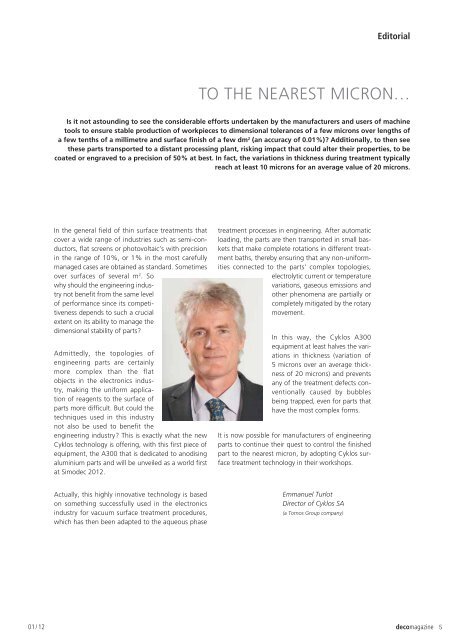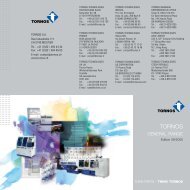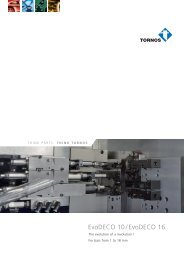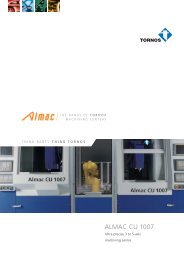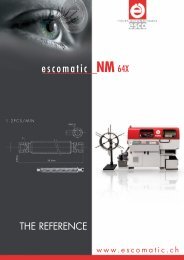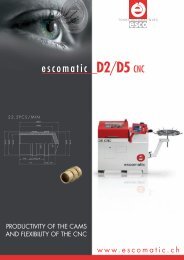Issue 60 - Tornos
Issue 60 - Tornos
Issue 60 - Tornos
- No tags were found...
Create successful ePaper yourself
Turn your PDF publications into a flip-book with our unique Google optimized e-Paper software.
EditorialTO THE NEAREST MICRON…Is it not astounding to see the considerable efforts undertaken by the manufacturers and users of machinetools to ensure stable production of workpieces to dimensional tolerances of a few microns over lengths ofa few tenths of a millimetre and surface finish of a few dm 2 (an accuracy of 0.01 %) ? Additionally, to then seethese parts transported to a distant processing plant, risking impact that could alter their properties, to becoated or engraved to a precision of 50 % at best. In fact, the variations in thickness during treatment typicallyreach at least 10 microns for an average value of 20 microns.In the general field of thin surface treatments thatcover a wide range of industries such as semi-conductors,flat screens or photovoltaic’s with precisionin the range of 10 %, or 1 % in the most carefullymanaged cases are obtained as standard. Sometimesover surfaces of several m 2 . Sowhy should the engineering industrynot benefit from the same levelof performance since its competitivenessdepends to such a crucialextent on its ability to manage thedimensional stability of parts ?Admittedly, the topologies ofengineering parts are certainlymore complex than the flatobjects in the electronics industry,making the uniform applicationof reagents to the surface ofparts more difficult. But could thetechniques used in this industrynot also be used to benefit theengineering industry ? This is exactly what the newCyklos technology is offering, with this first piece ofequipment, the A300 that is dedicated to anodisingaluminium parts and will be unveiled as a world firstat Simodec 2012.treatment processes in engineering. After automaticloading, the parts are then transported in small basketsthat make complete rotations in different treatmentbaths, thereby ensuring that any non-uniformitiesconnected to the parts’ complex topologies,electrolytic current or temperaturevariations, gaseous emissions andother phenomena are partially orcompletely mitigated by the rotarymovement.In this way, the Cyklos A300equipment at least halves the variationsin thickness (variation of5 microns over an average thicknessof 20 microns) and preventsany of the treatment defects conventionallycaused by bubblesbeing trapped, even for parts thathave the most complex forms.It is now possible for manufacturers of engineeringparts to continue their quest to control the finishedpart to the nearest micron, by adopting Cyklos surfacetreatment technology in their workshops.Actually, this highly innovative technology is basedon something successfully used in the electronicsindustry for vacuum surface treatment procedures,which has then been adapted to the aqueous phaseEmmanuel TurlotDirector of Cyklos SA(a <strong>Tornos</strong> Group company)01 / 12 decomagazine 5


